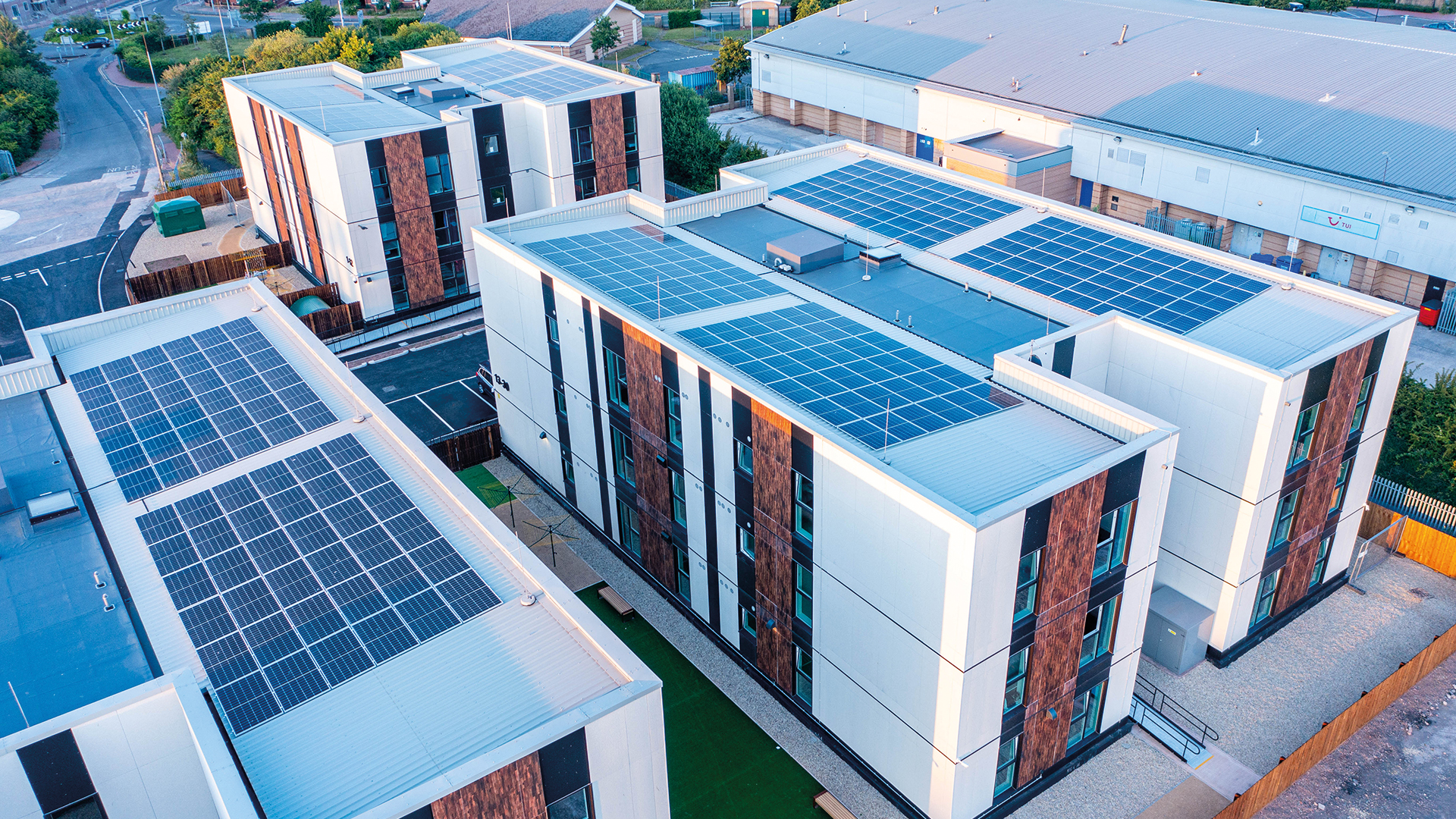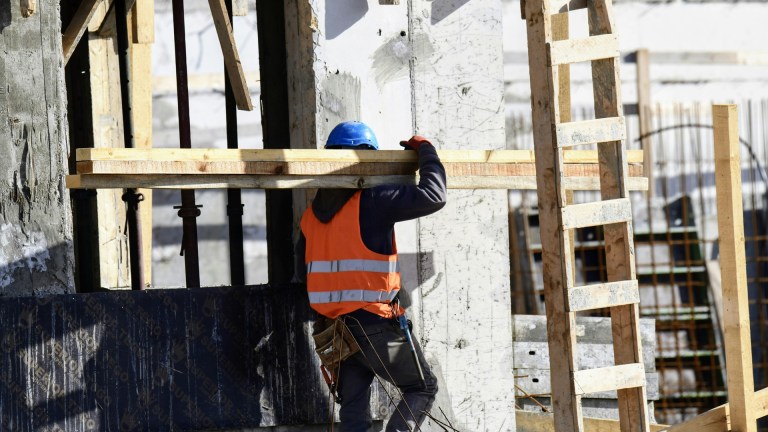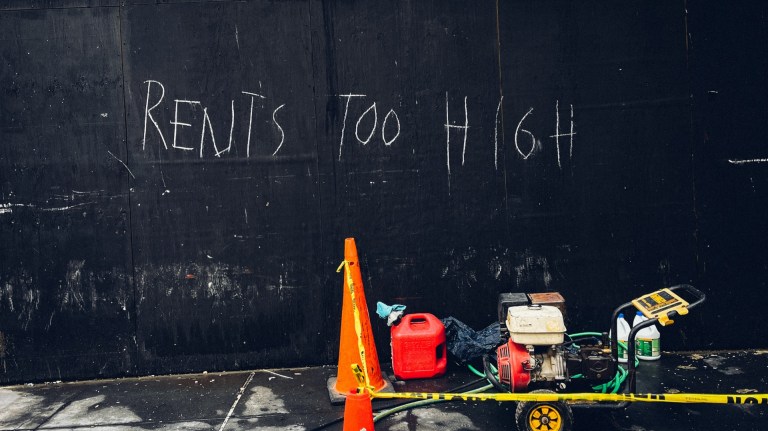So Housing First – the model that gives rough sleepers a home and support to get them off the streets for good – becomes a challenge when housing is at a premium. After all, you need potential homes to begin with.
Get the latest news and insight into how the Big Issue magazine is made by signing up for the Inside Big Issue newsletter
Modular housing has been filling the gap. The small, single-bedroom homes have popped up all over the country, allowing homelessness charities and local authorities to give vulnerable people a stable base and immediate access to support.
It’s been five years since the Social Bite village opened in Granton, near Edinburgh. The 22 modular homes at Jimmy’s came when the Everyone In scheme meant rough sleepers were being brought off the streets, mostly into hotels, to protect them from Covid.
Projects like Hope Rise – zero-carbon, social rent modular homes for young adults above a car park in Bristol – have sprung up since, while charities like Emmaus and the Lou Macari Foundation have also invested.
Local authorities nationwide have used modular homes to tackle homelessness in the face of broken local housing markets.
Advertising helps fund Big Issue’s mission to end poverty
Housebuilder The Hill Group has donated homes to many of the projects supporting people experiencing homelessness. Founder Andy Hill decided to give away 200 SoloHaus modular homes across the country to mark the company’s 20th anniversary.
“Andy originally created the company when he had been made redundant from another developer,” says The Hill Group’s SoloHaus project manager Rory Lowings.
“His feeling was that he was basically himself about a month away from homelessness. So what he wanted to do as part of the 20th anniversary celebrations is to say, ‘We’ve become a very successful firm, and would like to revisit that initial sense of not necessarily being in a position where you’re doing well.’” The £15m project has been running since 2019, and Lowings says it is approaching halfway complete.
Haringey Council are one of the latest Hill clients to have completed homes on the ground and became the first London borough to use modular homes to help rough sleepers.
The 33 SoloHaus homes cost £2.7 million, Haringey council leader Peray Ahmet tells The Big Issue, and have a big role to play as part of the local authority’s new rough sleeping strategy. “As a council we’re really keen to build more council homes, we are on a trajectory to build 3,000 council homes at council rent. But obviously, that doesn’t touch the sides. We’ve got 11,000 people on the social housing waiting list and 90,000 people in the private rented sector,” says Ahmet. “But the modular homes are cheap to construct and the bills are cheap. It’s preventative. People experiencing rough sleeping face a whole host of issues that we need to tackle, so what these homes should be doing is preparing those people for independence.
“It’s not just a case of placing people in a home, it’s also about the wraparound support and what we can do to try to prevent homelessness. At Oliver Morris Court [Haringey’s first site] I don’t believe anyone’s gone back to rough sleeping as a result of staying there. So the results are good.”
Advertising helps fund Big Issue’s mission to end poverty
The Hill Group’s modular housing projects have made the most of brownfield land in existing housing developments, utilising space that would have gone to waste. That means developments are close to local amenities, making it easier for low-income residents to access what they need and also limiting the environmental impact, with no reliance on cars to get around.
Tenancies typically run for two years but can last longer if residents aren’t ready to move on or if there is no affordable housing to move into. Some residents even want to stay in their homes permanently.
Research from the University of Cambridge’s Centre for Housing and Planning Research suggests that modular homes provide a better quality of life than that experienced temporary accommodation such as shared housing and hostels. But, despite the positive outcomes, there are limitations when it comes to tackling the wider housing crisis.
While Hill Group is working on a bigger version of the SoloHaus home, Lowings does not believe the modular homes are a silver bullet for the housing crisis. “Of course, 24 square metres is enough to give somebody a self-contained home, but nationally prescribed space standards exist for a reason and that’s what applies to the vast majority of development. We see ourselves as occupying a niche,” he says.
“The more we’ve done these schemes the more I see what we do as a successor to the early-modern Alms house principle. It was understood then, and is still understood now, that you’re always going to need a form of housing that caters to people in that transition phase between being fully settled in the community and not being completely settled and effectively being trapped in. Our modules do what they do very well. But they aren’t necessarily a solution for every housing situation.”
But can factory-built homes have a bigger say in the housing crisis?
Advertising helps fund Big Issue’s mission to end poverty
Two big suppliers have faced financial difficulties in 2023 as economic instability has hit the housing market. Legal and General halted production at its modular housing factory in May after demand slumped. The factory, in Selby, North Yorkshire, had capacity to build 3,000 modular homes a year but the company made reported losses of £176m before opting to close the factory with many of the 450 employees who worked there losing their jobs.
Meanwhile, Ilke Homes, who just last year were touting their zero-bill homes, went into administration in June. The modular housing firm, which received funding from government agency Homes England, owed a reported £320m when it slipped into administration after failing to find a buyer, leaving 1,150 employees facing redundancy. Both collapses sent shockwaves through a sector that looked on course for a bright future.
Ron Beattie, who runs modular house builder Beattie Passive, said the huge investment in capital expenditure to set up a factory and keep it running means there is great risk when it comes to building at scale, especially when demand drops.
“The challenges are that we have never been able to deliver on large numbers, because the industry has got so many barriers to it, whether it’s planning, logistics, or finance,” says Beattie, whose company provides modular homes in Cardiff. “So trying to set a company up with a capital expenditure of multi millions and then maintain that where you’ve got this ebb and flow of workflows coming through, it’s really difficult.
“I think the whole model is very, very dangerous. But some people will win, it will happen, it will grow when we can start getting the continuity of work, and the pipeline that needs to be sustainable.”
Despite the warnings, Beattie is still hoping to expand his operation from his current initial factory to “a factory in every city” and believes the environmental credentials of the modular housing sector means the sector could still have a big say in the future of housing in the UK.
Advertising helps fund Big Issue’s mission to end poverty
Beattie’s development at Yr Hafan in Cardiff claims to be the first relocatable residential modular housing development in Europe to hit the environmentally friendly Passivhaus Plus standard. Passivhaus is all about insulating to keep heat in and reusing hot air generated in the building to maintain temperature, reducing energy consumption.
The UK has the oldest and leakiest housing stock in Europe and modular housing could be part of an effort to reverse that, Beattie believes, alongside retrofit and more traditional newbuilds. “Our driver is to improve the quality of build, to build to net zero. To build to Passivhaus is the best, healthiest way to build a home,” says Beattie.
Modular housing will continue to make a difference: offering a taste of independence and a view towards a better life. Eamonn Kelly has just moved out of his modular home into a private rented flat where he has space for his family to visit.
“I lost my mum while I was in that pod, it meant a lot to me. There were a lot of memories in it,” says Kelly. “Without the help of Jimmy’s, I’d still be an addict. One thing about me: when someone gives me a chance, I don’t mess about, I don’t let people down.”
This article is taken from The Big Issue magazine out this week. Support your local vendor by buying today! If you cannot reach your local vendor, click HERE to subscribe to The Big Issue or give a gift subscription. You can also purchase one-off issues from The Big Issue Shop. The Big Issue app is available now from the App Store or Google Play









